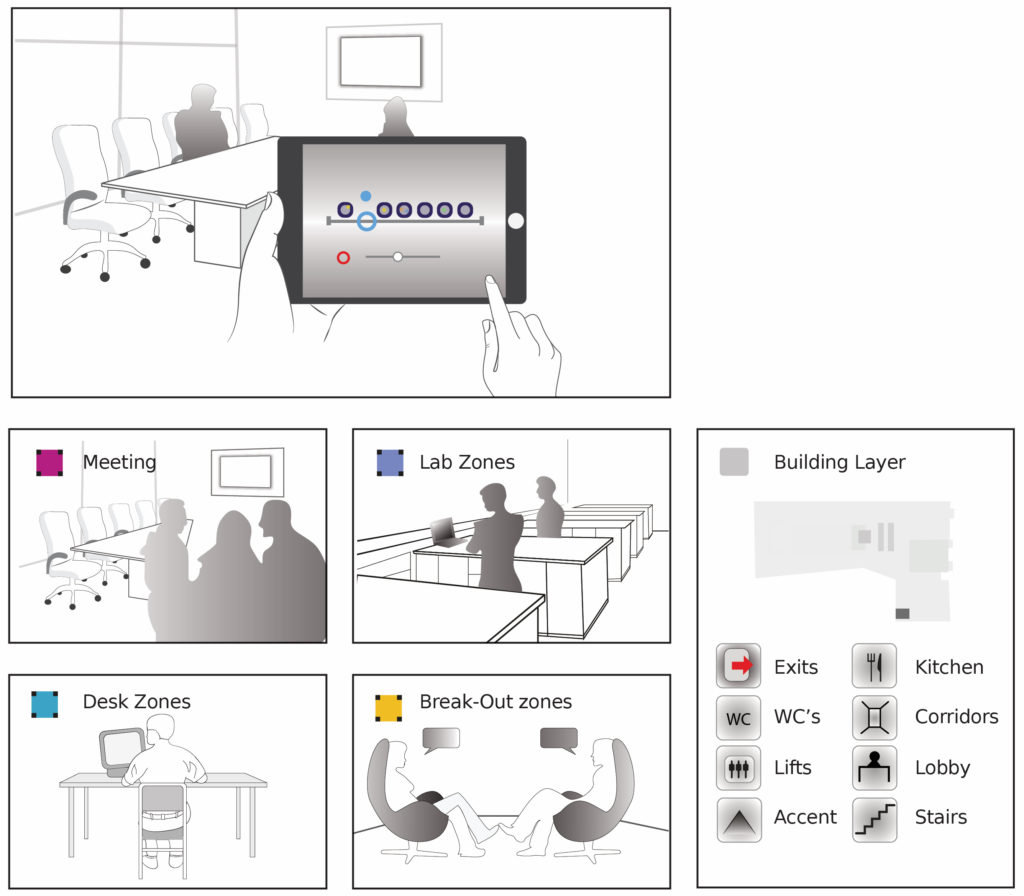Communications networks using Power over Ethernet (PoE) technology can now deliver electrical power, as well as transmit communications signals, over standard low-voltage Ethernet cabling to various endpoints, including LED lighting, HVAC controls, cameras and other networked devices, in new or existing commercial buildings. Giovanni Frezza, Group Product Manager for Network Connected Solutions at Molex, reviews PoE technology and standards, discussing how it can power smart lighting and building automation systems, and the benefits these can deliver for building operators and occupants.
PoE lighting and building automation systems, designed to promote energy efficiency and boost productivity, are beginning to drive highly innovative smart building concepts. As operational technology (OT) rapidly adopts PoE infrastructure in commercial buildings, including offices, factories and warehouses, architects, developers, builders and engineering firms become crucial collaborators, alongside information technology (IT), who have traditionally owned the infrastructure PoE utilises. Together, these proponents are leading the charge to bring powerful PoE networks into commercial spaces, with significant new build, retrofit and pilot installations underway — and many more in the works.
Forward-thinking adopters have recognised PoE infrastructure as a key asset for enabling IoT (Internet of Things) and smart building initiatives — one that can add significant value for building developers, operators and occupants. Advanced technologies are driving network-connected lighting use cases and more efficient standards in building automation. Unlike traditional networks that require dual-layer infrastructure (via separate power and communications networks), PoE platforms enable power and data to share the same low-voltage Ethernet cable infrastructure. Although many installed control systems today are based on proprietary solutions, leading technology suppliers and the commercial building industry are trending toward the use of open standards to simplify the commissioning, design, installation, configuration and maintenance of new networks.
The technologies used in PoE networks are well defined by various IEEE 802.3 standards, which specify the physical and data link layers for wired Ethernet networks, power sourcing equipment and devices using two-pair or four-pair connections to transmit power. The original PoE standard (IEEE 802.3af-2003), based on 15.4W per switch port of power, was increased to 25.5W in PoE+ (IEEE 802.3at-2009), using a two-pair power transfer format. The upcoming IEEE 802.3bt standard will utilise a four-pair power transfer format (4PPoE: 4 Pair Power over Ethernet), designed to introduce and support two additional power types: up to 60W (Type 3 or UPoE: Universal Power over Ethernet) and up to 90-100W (Type 4 or PoH: Power over HDBaseT) per switch port.
Utilising all four twisted pairs, UPoE technology can deliver more power than PoE+, with improved efficiency and reduced channel losses. Using UPoE, for instance, a PoE node can receive up to 51W of power. This allows the option to optimise the low-voltage cable infrastructure by daisy-chaining multiple devices on a single UPoE port, reducing the number of ports and amount of cabling required in a system. The new IEEE standards also improve efficiency and allow a wider range of device functions and support — and can be delivered on standard low-voltage Class D (Cat5e) cables using the same infrastructure that the IT industry has deployed for over a decade. A distributed network allows building or enterprise-wide precision control, integration with other building automation systems, and better data to inform workforce and building usage decisions.

Standards and specifications establish protocols for both power delivery and communications links for data exchange. However, this doesn’t tell the entire story about the value PoE networks can bring to building control systems. The proliferation of smart technologies is setting the stage, with architects, electricians and installers on the frontline using PoE LED fixtures to transform buildings. Legacy lighting fixtures can readily be retrofitted with LEDs and sensors capable of local smart control. These lighting systems in older buildings have utilised AC power that has been converted to low-voltage power. Retrofitting existing lighting fixtures with LEDs to replace fluorescent and compact fluorescent lighting was the first step for many building operators. Penetration in commercial building markets has made LEDs surprisingly cost competitive versus other lighting technologies. Outstanding lighting output per watt of power has been the primary driver of initial LED adoption in commercial buildings, greatly improving on traditional lighting technologies.
Advanced LED technologies are becoming increasingly versatile, efficient, secure and capable of supporting available wattages in PoE lighting systems. Meanwhile, the ability to migrate lighting controls to IP-based infrastructure is transforming lighting into a service and IoT building asset that can be controlled synergistically along with other building functions. Increased integration is driving not only better control, leading to drastic energy saving, increased occupant comfort and improved productivity, but also more meaningful and usable data collection by distributed sensor systems, as part of the lighting network infrastructure.
Optimised to deliver low-voltage power and reliable communications, PoE gateways distribute power and connect luminaires, sensor nodes, wall dimmers, and other local devices and controls to the IP network and control manager. Each gateway is connected to a switch port with a Cat5e cable. The IP nodes are responsible for power and data distribution to local devices. Lights, sensors, motorised blinds and other devices become digital objects that can be configured, grouped together and controlled via software. Good cable design is important to optimise the low-voltage power distribution for efficient and cost-effective implementation.
Well-implemented PoE control systems also deliver high availability of uninterrupted power service, greater network resiliency and reduced operating expenses. New networks and devices become faster to deploy since PoE networks do not require power outlets at each device endpoint. Commercial buildings are prime candidates for PoE lighting and automation systems, which can be either designed in as part of a building’s infrastructure or retrofitted into its existing infrastructure. Ideally, designs need to optimise power and data distribution in order to minimise the number of PoE ports required. If the power requirement for a group of devices is below 50W, for example, a single PoE gateway can power and control multiple drivers in a daisy-chain configuration. System software tools can provide support during the complete lifecycle of a networked control system, from design and installation to live operation, monitoring and building maintenance.
PoE networks can deliver a range of advantages for building operators, starting with the supply of both power and data over a single-layer infrastructure, using proven, scalable and future-proof standard Ethernet cable. The DC power supplied is ideal for LED and sensor applications, using low-voltage and safe-to-install standard RJ-45 connectors, without the need for a certified electrician. These PoE networks enable advanced control of highly tunable LED luminaries and dynamic/bio-adaptive controls, creating new paradigms and value in commercial building connectivity and data analytics. Easy convergence and integration with existing building automation systems and infrastructure allow digital zoning and re-zoning, increasing flexibility to optimise building zones for specific use cases, with easy repurposing to meet future needs. Granular sensor arrays allow superior automation and data reporting, as well as simple implementation of new use cases to increase productivity and operational efficiency.
PoE technology takes LED lighting in commercial spaces to the next level by further reducing energy consumption and improving quality of light, with smoother intensity and dimming functions, and dynamically adjustable colour output to create more comfortable and productive work environments. Building operators have ready access to light status, real-time energy consumption data, sensor-based occupancy reporting, air quality, temperature and other environmental monitoring. This aggregate data translates into tangible business insights in terms of flow patterns and space utilisation, conditions within those spaces, and how different spaces, floors, or buildings rank or compare in terms of occupancy, utilisation, energy usage and productivity.
The elimination of a dual-layer infrastructure to distribute power (via AC mains) and communication, data and control (via Ethernet on low-voltage cables or wirelessly) makes new construction simpler and faster than traditional hard-wired AC/DC distributed lighting and automation systems. Powered via low-voltage Ethernet cables and standard RJ-45 connectors, each LED light or element in the building also receives an IP address. Changes in space utilisation also benefit from reduced installation time and cost, by eliminating much rework of wiring. A network-connected system allows rapid changes in device parameter settings and zone programming simply by re-assigning sensors depending on space utilisation needs.
One of the most promising technologies allowing IP convergence for lighting and other building automation networks, the optimisation of PoE networks and low-voltage cable infrastructure requires hybrid deployment of technologies, including PoE and distributed power conversion. Experienced technology partners with domain knowledge are best suited to efficiently scale PoE technology in existing, new building or enterprise deployments.
Giovanni Frezza Group Product Manager, Molex

